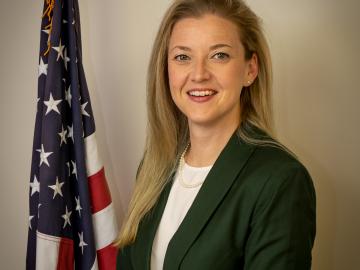Filter News
Area of Research
- Advanced Manufacturing (6)
- Biology and Environment (14)
- Building Technologies (1)
- Clean Energy (49)
- Computational Engineering (2)
- Computer Science (4)
- Electricity and Smart Grid (1)
- Fusion and Fission (7)
- Isotopes (5)
- Materials (13)
- Materials for Computing (14)
- Mathematics (1)
- National Security (4)
- Neutron Science (10)
- Quantum information Science (1)
- Sensors and Controls (1)
- Supercomputing (9)
- Transportation Systems (1)
News Type
Date
News Topics
- 3-D Printing/Advanced Manufacturing (21)
- Advanced Reactors (1)
- Artificial Intelligence (10)
- Big Data (8)
- Bioenergy (6)
- Biology (11)
- Biomedical (6)
- Biotechnology (3)
- Buildings (12)
- Chemical Sciences (11)
- Clean Water (7)
- Climate Change (15)
- Composites (8)
- Computer Science (21)
- Coronavirus (7)
- Critical Materials (7)
- Cybersecurity (4)
- Decarbonization (7)
- Energy Storage (19)
- Environment (23)
- Frontier (3)
- Fusion (8)
- Grid (9)
- High-Performance Computing (15)
- Isotopes (8)
- ITER (4)
- Machine Learning (4)
- Materials (32)
- Materials Science (18)
- Mathematics (1)
- Microscopy (7)
- Nanotechnology (7)
- National Security (5)
- Net Zero (2)
- Neutron Science (12)
- Nuclear Energy (2)
- Partnerships (2)
- Physics (2)
- Polymers (6)
- Quantum Computing (5)
- Quantum Science (8)
- Security (1)
- Simulation (3)
- Space Exploration (3)
- Statistics (3)
- Summit (5)
- Sustainable Energy (30)
- Transportation (16)
Media Contacts

Joan Bienvenue has been selected as the first executive director of the Oak Ridge Institute at the University of Tennessee, established last year to align the expertise and infrastructure of Oak Ridge National Laboratory and the university in support of world-leading research and talent development. As director, Bienvenue will also serve as a vice provost at UT. She begins her new position March 8.

To better understand the spread of SARS-CoV-2, the virus that causes COVID-19, Oak Ridge National Laboratory researchers have harnessed the power of supercomputers to accurately model the spike protein that binds the novel coronavirus to a human cell receptor.
A study by Oak Ridge National Laboratory, the University of Copenhagen, the National Park Service and the U.S. Geological Survey showed that hotter summers and permafrost loss are causing colder water to flow into Arctic streams, which could impact sensitive fish and other wildlife.

Oak Ridge National Laboratory researchers have demonstrated that a new class of superalloys made of cobalt and nickel remains crack-free and defect-resistant in extreme heat, making them conducive for use in metal-based 3D printing applications.

A multi-institutional team became the first to generate accurate results from materials science simulations on a quantum computer that can be verified with neutron scattering experiments and other practical techniques.

Thirty-two Oak Ridge National Laboratory employees were named among teams recognized by former DOE Secretary Dan Brouillette with Secretary’s Honor Awards as he completed his term. Four teams received new awards that reflect DOE responses to the coronavirus pandemic.

Three technologies developed by ORNL researchers have won National Technology Transfer Awards from the Federal Laboratory Consortium. One of the awards went to a team that adapted melt-blowing capabilities at DOE’s Carbon Fiber Technology Facility to enable the production of filter material for N95 masks in the fight against COVID-19.

Energy storage startup SPARKZ Inc. has exclusively licensed a battery cycling technology from ORNL designed to enable the rapid production of lithium-ion batteries commonly used in portable electronic devices and electric vehicles.

A better way of welding targets for Oak Ridge National Laboratory’s plutonium-238 production has sped up the process and improved consistency and efficiency. This advancement will ultimately benefit the lab’s goal to make enough Pu-238 – the isotope that powers NASA’s deep space missions – to yield 1.5 kilograms of plutonium oxide annually by 2026.

Collaborators at Oak Ridge National Laboratory and the University of Tennessee Health Science Center are developing a breath-sampling whistle that could make COVID-19 screening easy to do at home.




